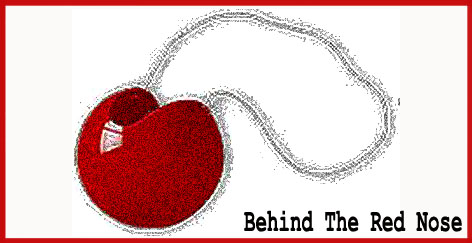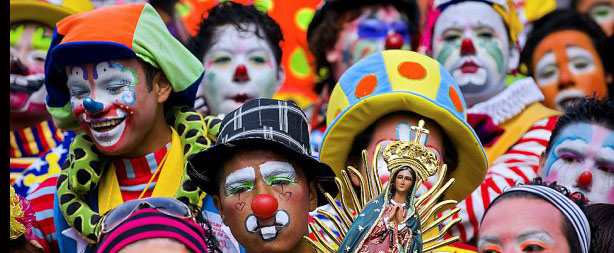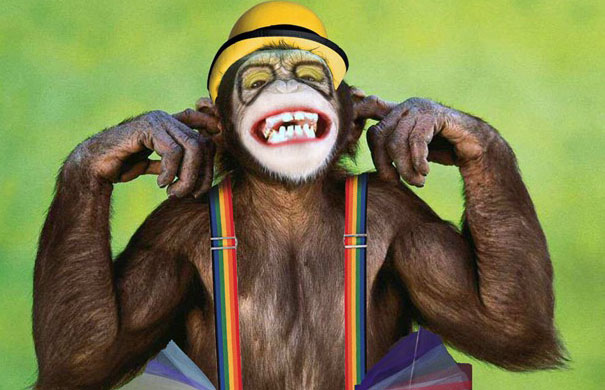Behind the Red Nose (Part One): Horror vs. Hilarity
Coulrophobia. It’s one of the top 10 most common phobias around the world. The BBC says it’s the third most prevalent phobia in Brittan, just behind spiders and needles. Symptoms vary from discomfort and wariness, high anxiety or to outright panic attacks. “I’m an educated adult, with irrational fears,” Kristine M. declared on one of the highly populated web forums where coulrophobics can share their torment with one another. Forrest Y., parent of three, agreed that it’s “a real irrational discomfort.” Despite the irrationality, “I’m not comfortable in any way, looking at them [and I] need to get out of that situation.”
To what dread fear are we referring? The fear of Steamboat Joe.
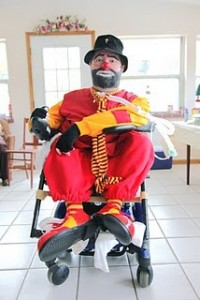 “My name is Jody Adams. My alter ego, or clown name, is Steamboat Joe.” Joe’s bold red and yellow costume is complete with the big shoes and red nose. He sports the traditional “Tramp” makeup, scruffy beard and accentuated mouth. Of course, he has a red nose. Joe also has a wheelchair. He can be seen, sitting jovially as Steamboat Joe, on his website, I Rode The Short Bus. “I am 34 and a life long survivor of Muscular Dystrophy. Throughout my childhood, I would appear on our local Jerry Lewis Telethon with Ronald McDonald and a Bozo-esque show called, ‘Happy Hour’ with Happy the clown.”
“My name is Jody Adams. My alter ego, or clown name, is Steamboat Joe.” Joe’s bold red and yellow costume is complete with the big shoes and red nose. He sports the traditional “Tramp” makeup, scruffy beard and accentuated mouth. Of course, he has a red nose. Joe also has a wheelchair. He can be seen, sitting jovially as Steamboat Joe, on his website, I Rode The Short Bus. “I am 34 and a life long survivor of Muscular Dystrophy. Throughout my childhood, I would appear on our local Jerry Lewis Telethon with Ronald McDonald and a Bozo-esque show called, ‘Happy Hour’ with Happy the clown.”
Steamboat Joe credits this early immersion into the world of clowns as a large part of the reason he donned the red nose. The largest motivator, for Steamboat Joe and his fellow clowns, was the chance to “make someone smile.” However, “we, as a society, are collectively afraid of clowns,” according to About Phobias.
There are two main schools of thought on how the fear of clowns has risen in our society. First is that the fear is based in a negative personal experience with a clown at a young age. This is a fairly common and accepted way of gaining a phobia and was true in the case of Lisa W., 45 of Arlington, who began fearing clowns around 6 or 7 at the circus. “A clown got right up in front of my face, and I could see his beard stubble underneath the clown makeup. He smelled bad and his eyes were weird… He had this smile painted on his face, but he was not smiling. He was yucky. Scary. Freaky. Weird.” Lisa is lucky, in the sense that at least she has a reason. Some early childhood trauma can be lost in the age before memory but still have an impact on the adults today.
The second theory is, of course, the media. That media has “created a hype surrounding evil clowns such that even children who are not personally exposed to clowns are trained to dislike or fear them.” Common examples of this are Chris from California, who says that “I think my fear stems from a Twilight Zone episode that I saw at a friend’s house in the fourth grade,” or Dorsi who wrote on www.ihateclowns.com that her fear “started with seeing Poltergeist when I was about 5, and then when I saw IT and eventually read the book.”
The struggle is that neither of these theories fully pinpoints the inception of clown fear as a cultural norm. Some posit, like Joseph Durwin, whose 2004 article for Trinity University is one of the most widely quoted coulrophobia resources, that clown fear runs even deeper than early trauma and is more pervasive than media hype. The joy which a clown inspires, or the fear which he may bring forth, has lurked in our hearts for generations.
But People Only Say That They’re Afraid of Clowns, Right?
“I had a friend who was a clown. When he died, all his friends went to the funeral in one car.”
-Stephen Wright
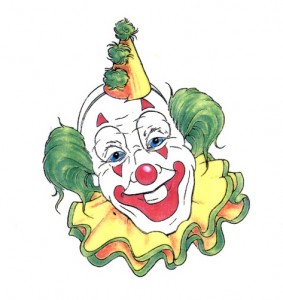 Regina McCann, 28 year-old mother of two, firmly upholds her clown fear as very real, and not the attention-seeking behavior which some critics pass off. “I just can’t stand it [seeing a clown]. I stiffen up, sweat and get goose-bumps.” According to Durwin’s collected accounts of coulrophobia, “it becomes evident that the torment they undergo has become a real and substantial phenomena which transcends the simple mass appeal that the theme of the ‘evil clown’ has in the horror genre…”
Regina McCann, 28 year-old mother of two, firmly upholds her clown fear as very real, and not the attention-seeking behavior which some critics pass off. “I just can’t stand it [seeing a clown]. I stiffen up, sweat and get goose-bumps.” According to Durwin’s collected accounts of coulrophobia, “it becomes evident that the torment they undergo has become a real and substantial phenomena which transcends the simple mass appeal that the theme of the ‘evil clown’ has in the horror genre…”
That reality can be equally hard to accept for dedicated clowns like Alex the Clown, who dove into the world of professional clowning in the Eighth Grade when his Career Exploration teacher exploded at his assertion that he wanted to be a clown when he grew up. “I wasn’t at all serious, I just thought it would be something funny to say,” Alex clarified, but his teacher’s unexpected response became “fuel to make a living as a clown.” Alex holds to the belief that “everyone benefits from laughter” though the Phobia Clinic indicates that legitimate coulrophobia “can cause panic attacks and keep people apart from loved ones and business associates” with symptoms like “shortness of breath, rapid breathing, irregular heartbeat, sweating, nausea, and overall feelings of dread.”
“People are typically frightened by things which are wrong in some way, wrong in a disturbingly unfamiliar way,” Professor Paul Salkovskis, clinical director of the Maudsley Hospital Centre for Anxiety Disorders and Trauma told the BBC News in 2008. This fear of the disturbingly unfamiliar may account for part of the traumatic effect of clowns on very young children who are negatively reactive to seeing typical bodies with strange faces.
Add simple mistrust of a person hidden behind greasepaint and oversized clothes to these scientific rationales and one can find themselves in an unexpectedly fearful predicament. “The fear actually makes sense to me,” said Skats the Clown. “The way being hidden behind my make-up makes me feel more safe because I’m hidden can make some people feel uneasy or even fearful because they have no idea who I am under all that.” Skats, once a humble balloon twister until a shot at the big-time required him to don the red nose, has felt a fear similar to one many non-acute couldrophobics feel. His most memorable performance was not one of the “fancy [New York] mixers at some really cool places” or a party for “some big names, really recognizable people” to which he has brought his foolish art. The show that which he had “never been more nervous before” was his family reunion. Why? The familiar clientele denied him the one thing which separates a clown from a mere mortal. “I had no mask or makeup to hide behind.”
Ladies, Gentlemen, Children of All Ages!
Though, according to Durwin, “many people who suffer from this specific anxiety disorder are middle-aged adults.” Yet one of the most striking difficulties in determining the cultural antecedents of clown fear is that it can affect anyone, male or female, young or old. In fact, “guess who was afraid of clowns when he was little?” Alex the Clown asked, rhetorically, “THIS GUY!” He said that the well-intentioned attitude in clown culture that a clown must be high energy all the time can lead people to feel overwhelmed, “uneasy or scared around something new or different.” He may have a point. Almost all of the 250 child patients which Nursing Standard magazine interviewed found clowns to be “universally scary, quite frightening and unknowable.”
As for the adults, “Many of them have a preconceived idea of clowns as knife-wielding psychos and they’re petrified, very frightened,” Paul Carpenter of John Lawson’s Circus told NewsCore earlier this year. He found that it was adults rather than children who needed therapy. Would they be less frightened if they knew that, on the other side of the red nose “the hardest part for clowns…is that they lack self confidence.” Alex the Clown confided that even the most boisterous of buffoons can be plagued by doubts and thoughts that “So-and-so has a much nicer balloon pump than I do.”
Step Right Up! See The Proto-Clown, Primordial Oddity!
“Since the first clown, there was someone afraid of them.”
-Steamboat Joe
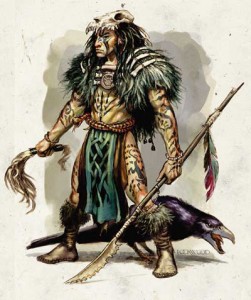 Until this point we’ve looked at the two sides of the coulrophobia debate; Childhood Trauma vs. Media Over-Sensitization. The time has come for us to delve deeper and darker because, since most noted couldrophobics are adult, Durwin argues that “one would think they’d have had their formative experiences prior to the fads, and before Stephen King terrorized America with Pennywise The Dancing Clown in the novel IT and film by the same name.”
Until this point we’ve looked at the two sides of the coulrophobia debate; Childhood Trauma vs. Media Over-Sensitization. The time has come for us to delve deeper and darker because, since most noted couldrophobics are adult, Durwin argues that “one would think they’d have had their formative experiences prior to the fads, and before Stephen King terrorized America with Pennywise The Dancing Clown in the novel IT and film by the same name.”
The purpose of a phobia is not fear, it is survival. A Swedish study found that subjects who had a snake or spider phobia were much more capable of spotting them amid distraction than their non-phobic counterparts. A brief, intriguing article discerned that “A lot of clown faces reduce the face to mostly a pair of huge eyes and an extremely large mouth, similar to what primitive man would have seen from predator animals.” Perhaps the initial fear in some phobics is the response of a deeply wired mechanism to that of a predator. But Durwin’s research has found that these predatory echoes have also been conditioned, anthropologically toward fear and awe.
Steamboat Joe said that his first performance, when he took on his alter ego for the first time, was his most memorable because “I was becoming part of something bigger than I am.” He was quite correct. Upon donning the red nose, he had tapped into ancestral history of Fools, Mystics and Shamans nearly as old as mankind and divided between early cultures.
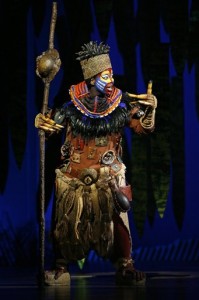 In Medieval culture“…the clown has been linked with The Fool…someone lacking common sense, if not totally devoid of reason- and encompasses a broad range of characters, including both the village idiot and the harmless eccentric…unimpressed with sacred ceremonies or the power of rulers, he is liable to be openly blasphemous and defiant; uninhibited in sexual matters, he often delight in obscene humor,” according to Durwin. Yet these harmless eccentrics also had power that the common man lacked, for they alone could mock the king.
In Medieval culture“…the clown has been linked with The Fool…someone lacking common sense, if not totally devoid of reason- and encompasses a broad range of characters, including both the village idiot and the harmless eccentric…unimpressed with sacred ceremonies or the power of rulers, he is liable to be openly blasphemous and defiant; uninhibited in sexual matters, he often delight in obscene humor,” according to Durwin. Yet these harmless eccentrics also had power that the common man lacked, for they alone could mock the king.
Charles Lucille noted in the Journal of American Folklore that nearly half of 136 early societies world-wide had shaman-clowns and many aboriginal tribal peoples venerated ritual clowning. In the plains of Central and North America, according to the classic study The Fool and His Scepter by William Willeford, “many individuals were called, usually as a result of dreams or visions, to engage in ‘contrary behavior’ including reverse speech patterns and the widespread trick of plunging their hands into boiling water…then splashing the water on their backs while complaining that it was cold [and other behavior that] took the form of clowning.” Such as acts of fake intercourse and transvestitism, both of which are still the practice of clowns today, though not the three clowns presently interviewed.
The clowns of the Jemez Pueblo would throw ash and sand on spectators, a possible ancestor of the confetti bucket. The Zuni Tribe’s Ne’Wekwe clown society “would break taboo by joking with the gods in English and Spanish, and even take it so far as to rig up fake telephones to converse with Zuni heaven.” Gags, props and jokes, but jokes with a purpose according to scholars like Durwin, Lucille and Willeford. “In the various tribal and larger cultural areas of North America clowning had magical functions of fertility, shamanism, curing, war and policing.”
The Monkey in the Box
“I was at a circus, and a clown came up to me and said, ‘Would you like to see the monkey I have in my box?’ Well, of course I did. So, I said yes. When I looked into the box, there was no monkey…only a mirror.’”
-Anonymous, www.IhateClowns.com
The fact is that the ancient clowns held power. Power to speak to the gods, power to lampoon the ruler, power to defy mores, norms, physics and personal space. Perhaps it is an echo of that venerable insanity which still chills comedian Eric Idle, “Clowns are grotesquely painted, horrifying, mad people who come lurching toward us, threatening us, involving us…They know no boundaries…” and they alone have the power to bring us into their world.
Tomorrow we will look toward clowns which are nothing like jovial Steamboat Joe, witty Alex the Clown, or good-natured Skats. Tomorrow we will visit Weary Willy, the clown who ate three men, Pogo the Serial Killer and Pennywise, the Media Nightmare.
Today we must return to our world either joyful at meeting three fun loving clowns, or chilled by the feeling that maybe, generations after god-touched shamans cavorted in tribal rituals, we are still trapped in the spell of the clown. Just like the monkey in the box.
Join us tomorrow for Behind the Red Nose (Part II): Fear vs. Frivolity! Please drop a line (or some business) on Steamboat Joe, Skats, and Alex the Clown. I am quite grateful to these three fine, kind hearted, grease painted gentlemen. This article would be much less without them.
K

